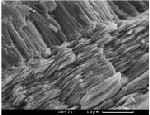Mechanics of Complex Composite Ceramics
| Working Group: | WG Numerics of PDEs |
| Leadership: | Prof. Dr. Alfred Schmidt ((0421) 218-63851, E-Mail: alfred.schmidt@uni-bremen.de ) |
| Processor: | Dr. Bettina Suhr |
| Project partner: | AG Grathwohl, Keramische Werkstoffe und Bauteile |
| Time period: | 01.10.2005 - 30.11.2006 |
 Biogenic ceramic composites, where biopolymers are embedded in a ceramic matrix, achieve mechanical properties whose quality is far superior to those of the starting products and have minimum material consumption under physiological conditions. In this area, nature is considerably more versatile and finds integral, multifunctional material solutions which cannot yet be realised with present-day technical materials (e.g. mother-of-pearl, bones).
Biogenic ceramic composites, where biopolymers are embedded in a ceramic matrix, achieve mechanical properties whose quality is far superior to those of the starting products and have minimum material consumption under physiological conditions. In this area, nature is considerably more versatile and finds integral, multifunctional material solutions which cannot yet be realised with present-day technical materials (e.g. mother-of-pearl, bones).
The modelling and systematic understanding of how they work is one of the fundamental challenges of material science [?]. A particular difficulty lies in the necessary combination of microscopic material parameters and the macroscopic way in which they function. Modelling here requires that several orders of magnitude from the molecular scale to the physical size of the workpiece have to be overcome.
Mother-of-pearl comprises 95% aragonite (calcium carbonate) and 5% biopolymers [?]. These biopolymers form a thin boundary layer between the elongated stacked crystals, see Figure 9. This gives the snail's shell made of mother-of-pearl an energy of fracture which is almost 1000 times higher than pure aragonite.
Since the material properties of this biopolymer layer cannot be determined experimentally owing to its thinness (and the requisite environmental properties), simulations of the composite material can only compare different approaches. Models for (non-linear) elasticity, visco-elasticity etc. are utilised for this. A homogenisation approach for the non-linear material laws which occur here has not yet been elucidated. The mechanical properties of the composite structure can be simulated in complex 2D and 3D computations in which both the aragonite laminae and the biopolymer layer have to be solved.

